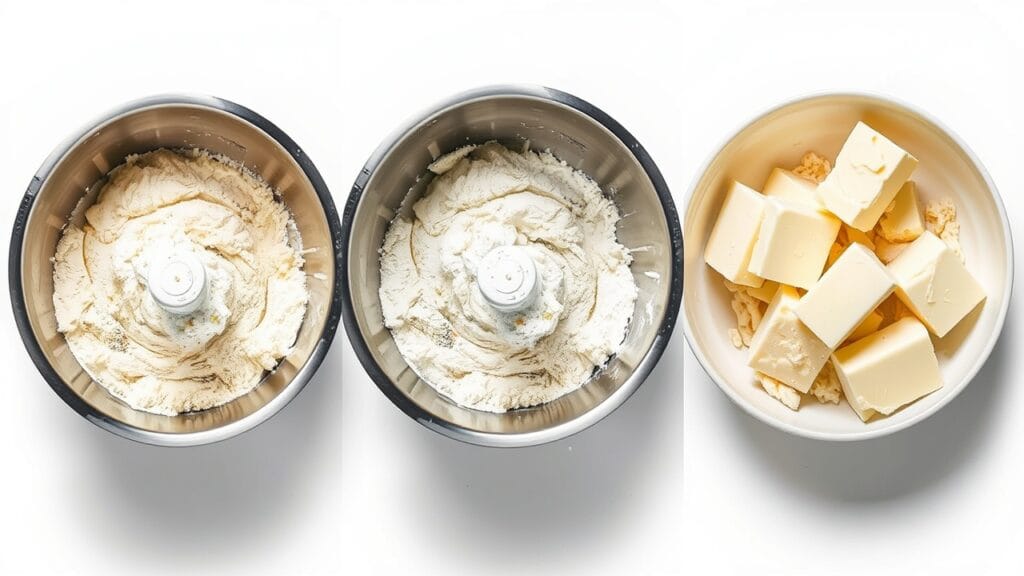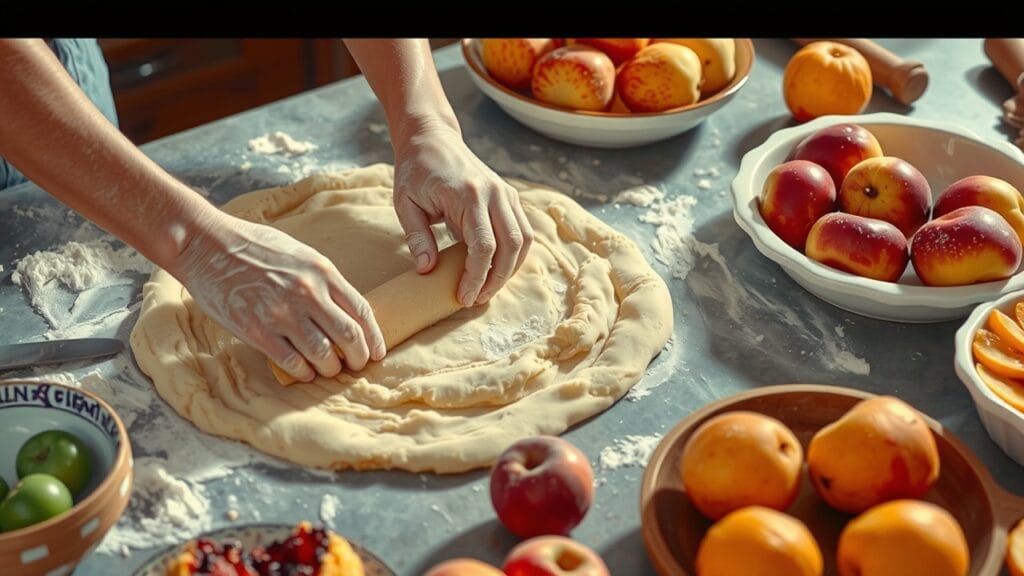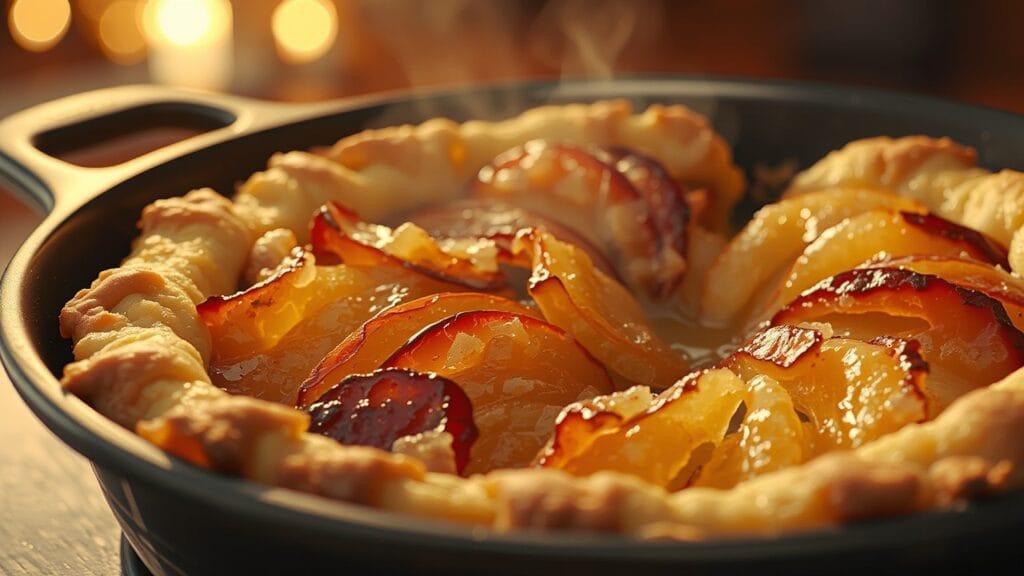Introduction to Cobbler Crust
Cobbler is one of those delightful desserts that brings a sense of nostalgia and comfort. Imagine a baking dish filled with sweet, juicy fruit bubbling beneath a golden, crumbly crust. Whether you’re making a peach, apple, or berry cobbler, the crust plays a crucial role in creating that perfect dessert. But what exactly is cobbler crust made of? In this article, we’ll dive into the ingredients and techniques that make cobbler crust so special, and how you can master it at home.
Definition and History of Cobbler Crust
The origins of cobbler date back to early American settlers who improvised with the ingredients they had on hand. Unable to make traditional pies due to the lack of proper baking equipment, they covered stewed fruit with a layer of biscuit dough and baked it over an open fire. This rustic dessert evolved into what we now know as cobbler, with variations popping up across regions.
The term “cobbler” likely comes from the dessert’s appearance, which resembles a cobbled street with its rough, uneven surface. Unlike pies that have a smooth, even crust, cobblers are known for their textured, biscuit-like topping. This unique crust is what sets cobbler apart and makes it a favorite among dessert lovers.
“Cobbler’s rough, cobbled appearance is a nod to its rustic roots, making it a charming and comforting dessert.”
Basic Ingredients of Cobbler Crust
Flour: The Foundation
Flour is the main ingredient in cobbler crust, providing structure and stability. All-purpose flour is commonly used, but you can experiment with whole wheat or gluten-free flours depending on your dietary preferences. The flour’s role is to create a sturdy base that can hold up to the juicy fruit filling without becoming soggy.
Sugar: Sweetening the Crust
A touch of sugar adds sweetness to the crust, balancing the tartness of the fruit. Granulated sugar is the standard choice, but brown sugar can add a deeper, caramel-like flavor. The amount of sugar can vary depending on your preference and the sweetness of the fruit you’re using. Just a few tablespoons are enough to enhance the crust without overpowering it.
Butter: Adding Richness
Butter is essential for a rich, flavorful cobbler crust. It adds moisture and helps create a tender, flaky texture. Cold, unsalted butter is cut into the flour mixture, creating small pockets of fat that melt during baking, resulting in a light, crumbly crust. Some recipes might call for shortening or a combination of butter and shortening for an even flakier texture.
Milk or Cream: For Moisture
Milk or cream is added to the dry ingredients to bring the dough together. It adds moisture and richness, ensuring the crust is tender and not too dry. Whole milk, buttermilk, or heavy cream can be used depending on the richness you desire. Buttermilk adds a slight tang that complements the sweetness of the fruit.
“The combination of flour, sugar, butter, and milk creates a crust that’s both tender and flavorful, perfectly complementing the juicy fruit filling.” 🧈🥛
Variations in Cobbler Crust Recipes

Gluten-Free Cobbler Crust
For those with gluten sensitivities, a gluten-free cobbler crust is a great alternative. You can use a gluten-free all-purpose flour blend, which is available in most grocery stores. These blends often contain a mix of rice flour, potato starch, and tapioca flour, which mimic the properties of wheat flour. Adding a bit of xanthan gum can help bind the dough together and improve the texture.
Vegan Cobbler Crust
A vegan cobbler crust can be made by substituting dairy and eggs with plant-based alternatives. Use a vegan butter or coconut oil in place of traditional butter. For the liquid, almond milk, soy milk, or any other plant-based milk can be used. These substitutes maintain the crust’s richness and moisture while adhering to a vegan diet.
Low-Sugar Cobbler Crust
If you’re looking to reduce your sugar intake, you can make a low-sugar cobbler crust without sacrificing flavor. Use a natural sweetener like stevia or monk fruit sweetener in place of granulated sugar. You can also reduce the amount of sweetener and rely on the natural sweetness of the fruit filling. Using fresh, ripe fruit can enhance the dessert’s flavor without the need for extra sugar.
> “There are endless ways to customize your cobbler crust to suit dietary preferences and health goals, making it a versatile dessert for everyone to enjoy.”
Common Problems with Cobbler Crust
Crust Too Hard or Tough
One common issue with cobbler crust is that it can turn out too hard or tough. This usually happens when the dough is overmixed or the butter is not cold enough. Overmixing develops the gluten in the flour, resulting in a dense, tough crust. Similarly, if the butter is too warm, it won’t create the desired pockets of fat, leading to a hard crust.
Crust Too Soggy
Another problem is a soggy crust. This can occur if there is too much liquid in the fruit filling or if the crust is underbaked. The juices from the fruit can seep into the crust, making it mushy. Additionally, baking at a lower temperature or for too short a time can prevent the crust from crisping up properly.
Uneven Baking
Uneven baking is another issue that can affect the quality of your cobbler crust. This can happen if the oven temperature is inconsistent or if the cobbler is not placed correctly in the oven. Unevenly rolled dough can also contribute to this problem, with thinner areas baking faster and thicker areas remaining undercooked.
“Understanding common issues with cobbler crust can help you troubleshoot and achieve the perfect texture every time.”
Nutrition Facts (Per Serving for Basic Cobbler Crust)
| Ingredient | Quantity |
|---|---|
| All-Purpose Flour | 1 cup |
| Granulated Sugar | 2-3 tbsp |
| Unsalted Butter | 1/2 cup |
| Milk or Cream | 1/2 cup |
Solutions to Common Cobbler Crust Problems
Achieving the Perfect Texture
Getting the texture just right is key to making an excellent cobbler crust. Here are some tips to ensure your crust is tender and flaky:
- Use Cold Butter: Ensure your butter is very cold before cutting it into the flour. This helps create pockets of fat that melt during baking, producing a flaky texture.
- Handle the Dough Gently: Avoid overmixing the dough. Mix just until the ingredients are combined. Overworking the dough can develop the gluten, leading to a tough crust.
- Chill the Dough: If you have time, chill the dough for 30 minutes before baking. This allows the butter to firm up again, which helps create a better texture.
Ensuring Even Baking
Even baking is crucial for a cobbler crust that is uniformly cooked and golden brown. Here are some strategies:
- Preheat Your Oven: Always preheat your oven to the correct temperature before baking. This ensures an even cooking temperature from the start.
- Use a Baking Stone: Placing your baking dish on a preheated baking stone can help distribute heat more evenly.
- Rotate the Dish: Halfway through the baking time, rotate the dish to ensure even cooking. This can help counteract any hot spots in your oven.
Adjusting Sweetness and Richness
Getting the right balance of sweetness and richness can take your cobbler crust from good to great. Here are some adjustments you can make:
- Taste Your Fruit: If your fruit is very sweet, you might reduce the amount of sugar in the crust. Conversely, if your fruit is tart, a bit more sugar in the crust can create a nice balance.
- Add a Bit of Cream: For a richer crust, replace some of the milk with heavy cream. This adds a luxurious texture and flavor.
- Experiment with Flavors: Try adding a dash of vanilla extract, almond extract, or spices like cinnamon and nutmeg to the crust dough to complement the flavors of your fruit filling.
“Small adjustments in ingredients and techniques can significantly improve the texture and flavor of your cobbler crust, ensuring it complements the filling perfectly.”
Tips for Making the Best Cobbler Crust

Choosing the Right Ingredients
The quality of your ingredients can make a big difference in the final product. Here are some tips for selecting the best ingredients:
- Fresh, High-Quality Butter: Use unsalted, high-quality butter for the best flavor and texture.
- Good Flour: Use a reputable brand of all-purpose flour. If you’re using alternative flours, ensure they’re fresh and free from any off-tastes.
- Real Vanilla Extract: If you’re adding flavorings, choose pure extracts rather than imitation ones for a more authentic taste.
Proper Mixing Techniques
How you mix your ingredients can affect the texture of the crust. Here are some techniques to keep in mind:
- Use a Pastry Cutter: A pastry cutter or two knives can help cut the butter into the flour without melting it. This keeps the butter cold and creates the desired flaky texture.
- Don’t Overmix: Mix the dough just until it comes together. Overmixing can develop the gluten in the flour, making the crust tough.
- Incorporate Ingredients Evenly: Ensure that the butter is evenly distributed throughout the flour mixture. This helps create a uniform texture in the crust.
Baking Tips and Tricks
Baking your cobbler crust to perfection requires attention to detail. Here are some tips to ensure success:
- Bake Until Golden Brown: The crust should be a deep golden brown when it’s done. This ensures that it’s fully cooked and has a nice, crisp texture.
- Check for Doneness: Insert a toothpick into the crust. If it comes out clean or with just a few crumbs clinging to it, the crust is done.
- Let It Rest: Allow the cobbler to cool slightly before serving. This helps the juices thicken and makes it easier to serve.
> “Attention to detail in ingredient selection, mixing, and baking can elevate your cobbler crust, making it a delicious and essential part of the dessert.”
Popular Cobbler Crust Recipes
Classic Peach Cobbler Crust
Here’s a classic recipe for peach cobbler crust:
Ingredients:
- 1 cup all-purpose flour
- 2-3 tablespoons granulated sugar
- 1/2 cup unsalted butter, cold and cubed
- 1/2 cup whole milk
- 1 teaspoon baking powder
- Pinch of salt
Instructions:
- Preheat your oven to 375°F (190°C).
- In a large bowl, whisk together the flour, sugar, baking powder, and salt.
- Cut in the cold butter using a pastry cutter until the mixture resembles coarse crumbs.
- Stir in the milk just until the dough comes together.
- Drop spoonfuls of dough over the peach filling in your baking dish.
- Bake for 35-40 minutes, or until the crust is golden brown and the filling is bubbly.
Berry Cobbler Crust
Try this delightful recipe for berry cobbler crust:
Ingredients:
- 1 cup whole wheat flour
- 2 tablespoons brown sugar
- 1/2 cup unsalted butter, cold and cubed
- 1/2 cup buttermilk
- 1/2 teaspoon cinnamon
- 1 teaspoon baking soda
- Pinch of salt
Instructions:
- Preheat your oven to 375°F (190°C).
- In a large bowl, whisk together the flour, sugar, cinnamon, baking soda, and salt.
- Cut in the cold butter using a pastry cutter until the mixture resembles coarse crumbs.
- Stir in the buttermilk just until the dough comes together.
- Drop spoonfuls of dough over the berry filling in your baking dish.
- Bake for 35-40 minutes, or until the crust is golden brown and the filling is bubbly.
Apple Cobbler Crust
Here’s a delicious recipe for apple cobbler crust:
Ingredients:
- 1 cup all-purpose flour
- 3 tablespoons granulated sugar
- 1/2 cup unsalted butter, cold and cubed
- 1/2 cup heavy cream
- 1 teaspoon nutmeg
- 1 teaspoon baking powder
- Pinch of salt
Instructions:
- Preheat your oven to 375°F (190°C).
- In a large bowl, whisk together the flour, sugar, nutmeg, baking powder, and salt.
- Cut in the cold butter using a pastry cutter until the mixture resembles coarse crumbs.
- Stir in the heavy cream just until the dough comes together.
- Drop spoonfuls of dough over the apple filling in your baking dish.
- Bake for 35-40 minutes, or until the crust is golden brown and the filling is bubbly.
“Experimenting with different cobbler crust recipes can help you discover your favorite version, each bringing its own unique flavor and texture to the table.”
Nutrition Facts (Per Serving for Classic Peach Cobbler Crust)
| Nutrient | Amount |
|---|---|
| Calories | 210 |
| Total Fat | 11g |
| Saturated Fat | 7g |
| Cholesterol | 30mg |
| Sodium | 200mg |
| Total Carbohydrates | 25g |
| Dietary Fiber | 1g |
| Sugars | 10g |
| Protein | 3g |
Popular Cobbler Crust Recipes
Gluten-Free Peach Cobbler Crust
For those who are gluten-sensitive, this gluten-free peach cobbler crust recipe ensures you don’t miss out on enjoying a delicious cobbler:
Ingredients:
- 1 cup gluten-free all-purpose flour
- 3 tablespoons granulated sugar
- 1/2 cup unsalted butter, cold and cubed
- 1/2 cup almond milk
- 1 teaspoon xanthan gum
- Pinch of salt
Instructions:
- Preheat your oven to 375°F (190°C).
- In a large bowl, whisk together the gluten-free flour, sugar, xanthan gum, and salt.
- Cut in the cold butter using a pastry cutter until the mixture resembles coarse crumbs.
- Stir in the almond milk just until the dough comes together.
- Drop spoonfuls of dough over the peach filling in your baking dish.
- Bake for 35-40 minutes, or until the crust is golden brown and the filling is bubbly.
Vegan Mixed Berry Cobbler Crust
This vegan cobbler crust recipe uses plant-based ingredients to create a delicious and cruelty-free dessert:
Ingredients:
- 1 cup all-purpose flour
- 3 tablespoons brown sugar
- 1/2 cup vegan butter, cold and cubed
- 1/2 cup coconut milk
- 1 teaspoon baking powder
- Pinch of salt
Instructions:
- Preheat your oven to 375°F (190°C).
- In a large bowl, whisk together the flour, brown sugar, baking powder, and salt.
- Cut in the cold vegan butter using a pastry cutter until the mixture resembles coarse crumbs.
- Stir in the coconut milk just until the dough comes together.
- Drop spoonfuls of dough over the berry filling in your baking dish.
- Bake for 35-40 minutes, or until the crust is golden brown and the filling is bubbly.
Low-Sugar Apple Cobbler Crust
For those looking to reduce their sugar intake, this low-sugar cobbler crust is perfect:
Ingredients:

- 1 cup whole wheat flour
- 1 tablespoon monk fruit sweetener
- 1/2 cup unsalted butter, cold and cubed
- 1/2 cup unsweetened almond milk
- 1 teaspoon cinnamon
- 1 teaspoon baking powder
- Pinch of salt
Instructions:
- Preheat your oven to 375°F (190°C).
- In a large bowl, whisk together the flour, monk fruit sweetener, cinnamon, baking powder, and salt.
- Cut in the cold butter using a pastry cutter until the mixture resembles coarse crumbs.
- Stir in the almond milk just until the dough comes together.
- Drop spoonfuls of dough over the apple filling in your baking dish.
- Bake for 35-40 minutes, or until the crust is golden brown and the filling is bubbly.
“Experimenting with different dietary-friendly recipes ensures everyone can enjoy the comfort and deliciousness of cobbler.”
Conclusion
Summary of Key Points
Creating the perfect cobbler crust involves understanding its key ingredients and mastering the techniques for achieving the ideal texture and flavor. Whether you prefer the classic approach with flour, sugar, butter, and milk, or need a variation to suit dietary restrictions, there are plenty of ways to make a delicious cobbler crust. Common problems like a tough or soggy crust can be easily fixed with the right tips and techniques, ensuring your cobbler turns out perfect every time.
Encouragement to Experiment
Don’t be afraid to experiment with different ingredients and techniques to find your ideal cobbler crust. Try adding unique flavors or using alternative flours and sweet.

